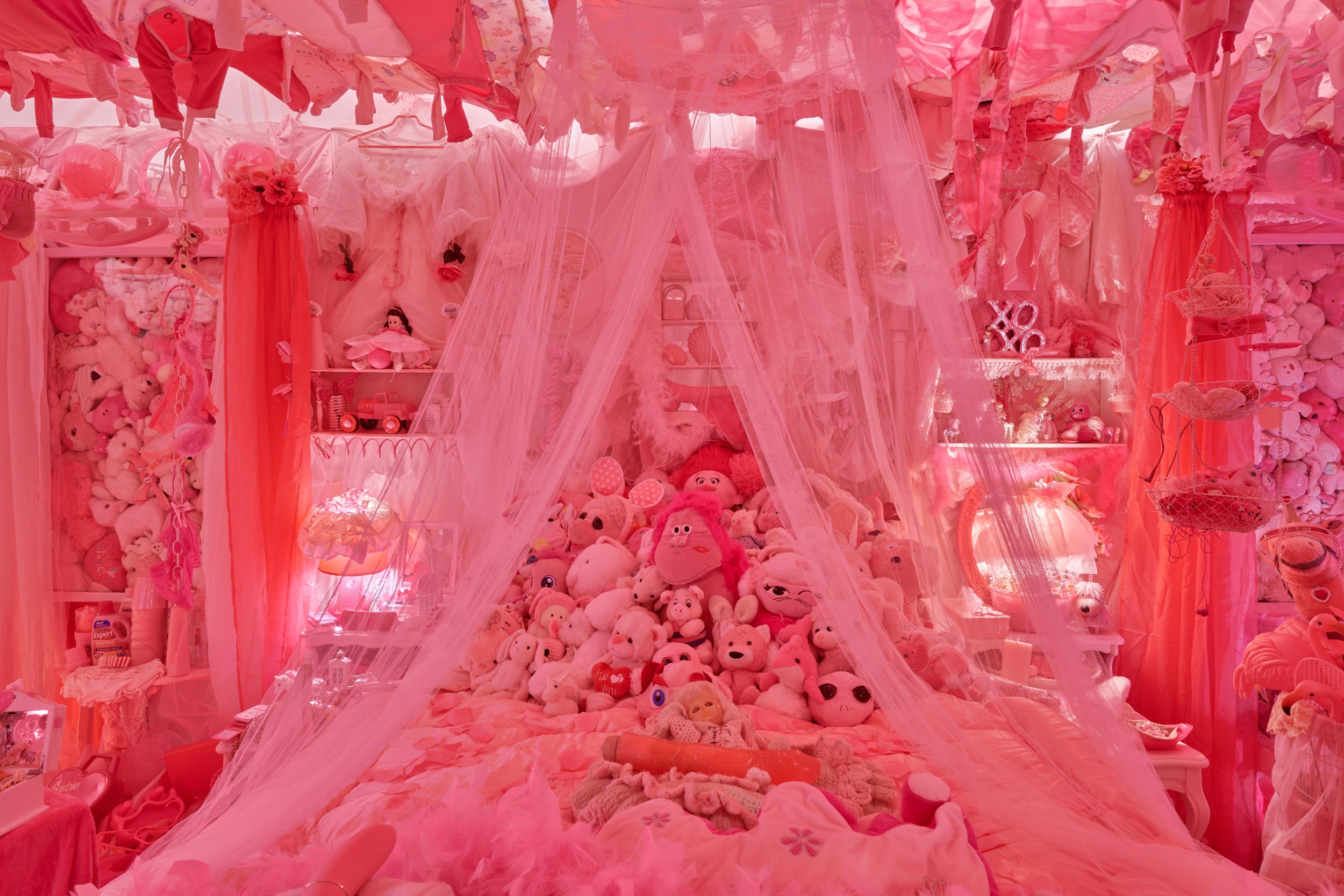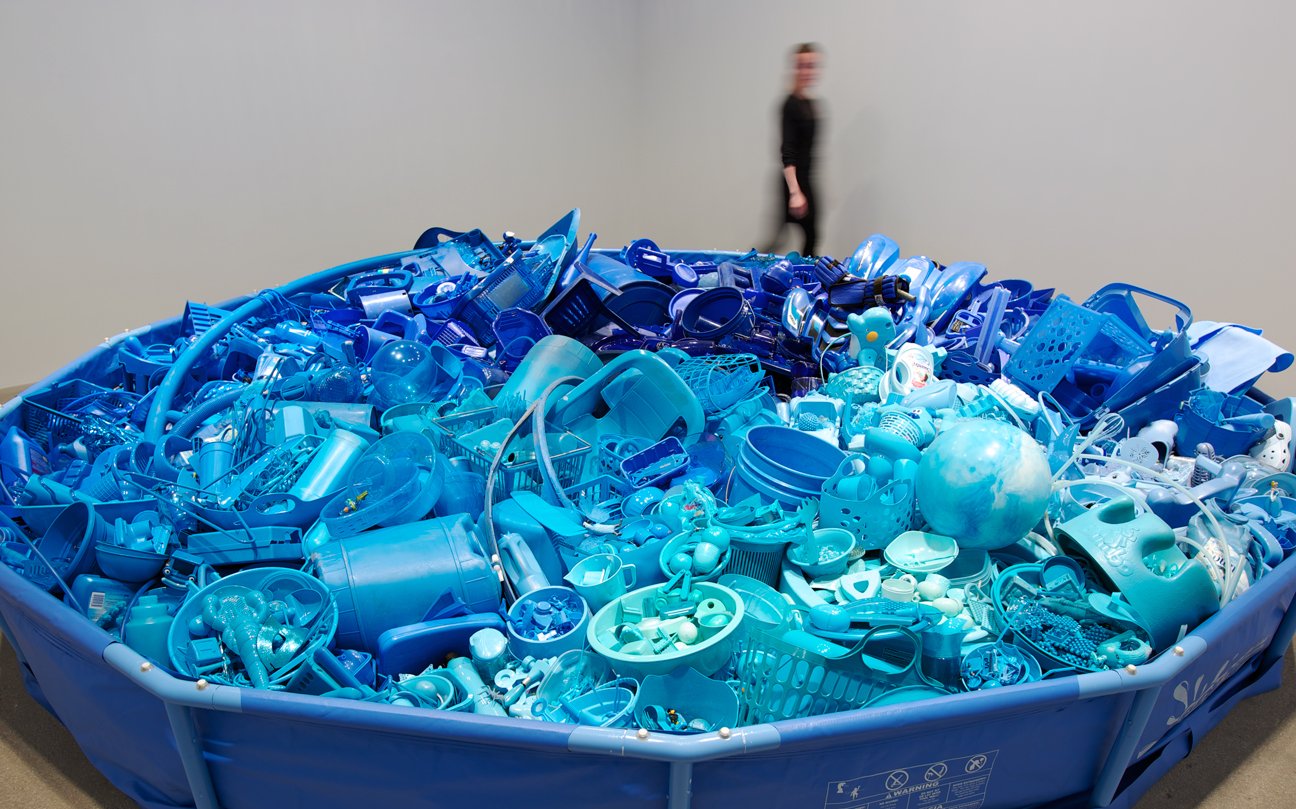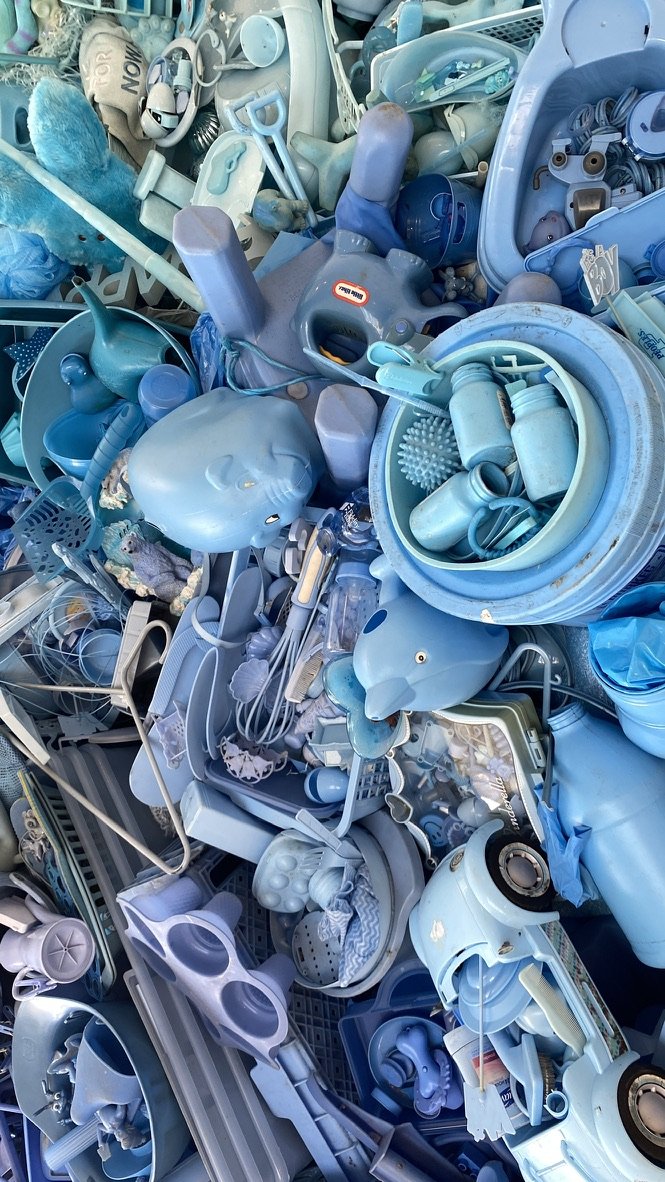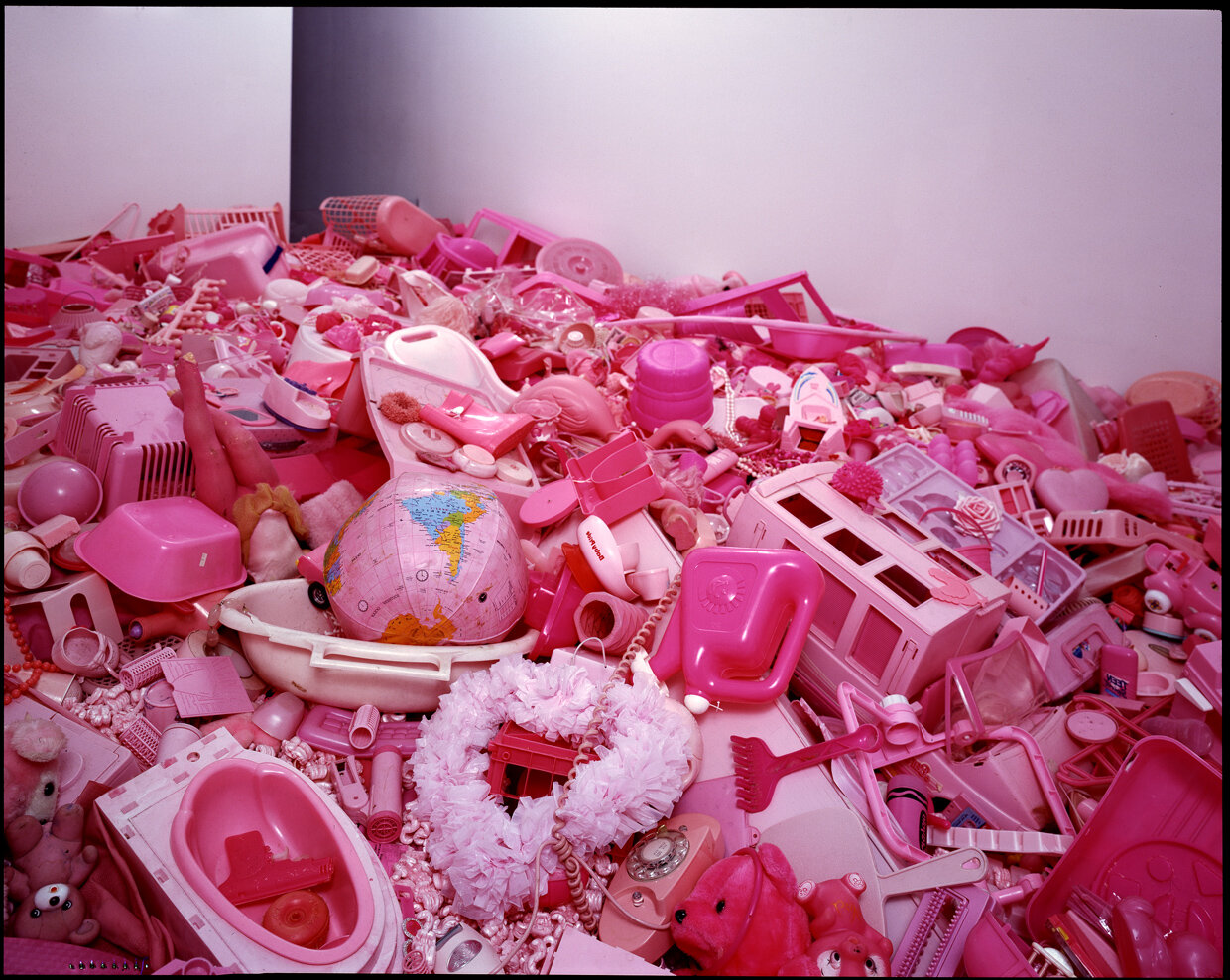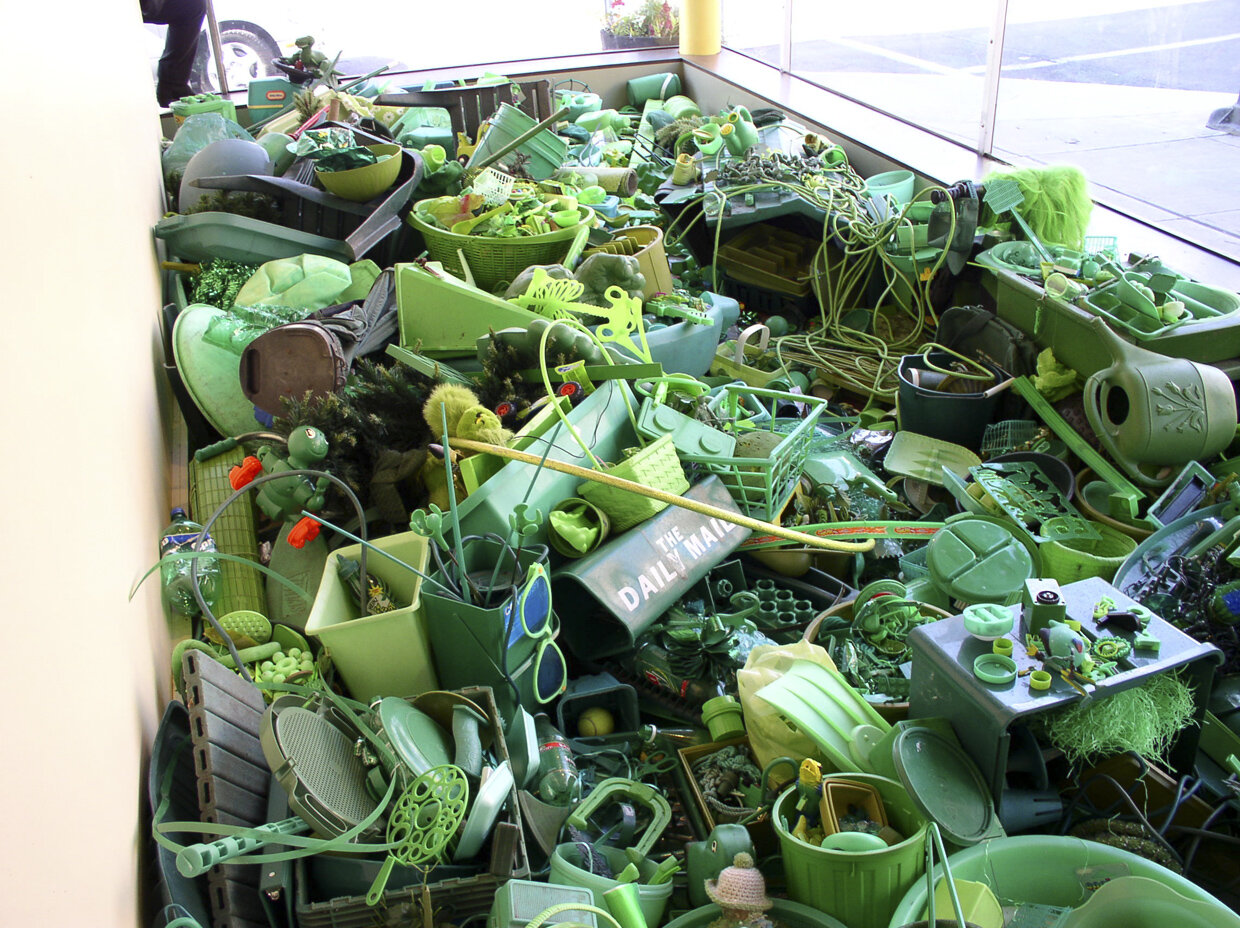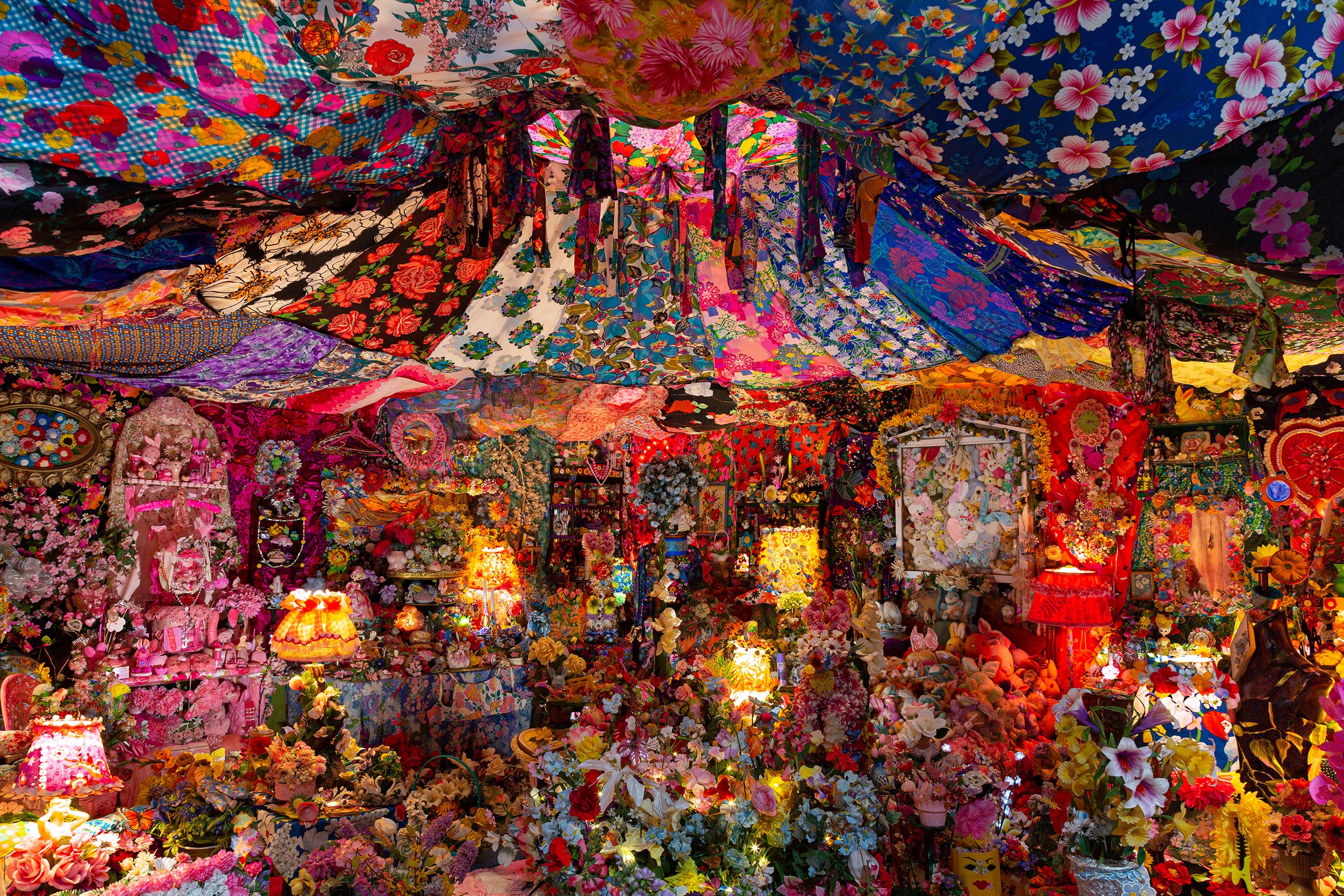
“My art installations are a contemplations of and comment on our manufactured perceptions of nature. We as a culture are defined by the objects we mass-produce, consume, and throw away. I collect these objects and assemble them into congested installations, in essence using as my resource the refuse of consumer culture that usually end up in landfills, what you might call “the backside of the mall.” “
Pink Project, first exhibited in the New Museum’s Bad Girls exhibition in 1994, consists of thousands of discarded pink objects carefully arranged on a large table. It is a visual overload of products that were created to appeal specifically to women and girls, including hair clips, pacifiers, fake fingernails, combs, dildos, cleaning products, toys, tampon applicators, kitchen gadgets and hundreds of other items, all representing mass seduction and consumption. The Pink Project has taken various forms: as a sculpture, presented in glass vitrines, as a room sized mound, a bedroom, and a glass coffin.
Each iteration of the work has revealed the marketing of femininity and the infantilization of the female gender while also exploring the cultural loaded color pink and its continued social projection onto girls and women.
By 1996 I had become increasingly interested in environmental issues, seeing the Pink Project as not only commenting on gender marketing but also the waste that accompanies consumption. My next piece, The Garden (fist exhibited in New York in 1996), is an artificial garden one can enter, a room densely packed and layered with recycled manufactured items (mainly gathered from free thrift shops at New England Dumps and transfer stations) representing/depicting flowers and creatures found in gardens and associated with women. A quilt of floral dresses covers the ceiling and walls, creating a canopy for the garden glowing beneath. Lamps are encrusted with plastic daisies; tall bunny rabbits smothered in fake flowers stand guard. Floors are flooded with blossoms; a floral love seat and adorned bed sit among clusters of floral consumer commodities appearing to have grown over every square inch of surface. In creating this work I was thinking about how ideas of nature and beauty are marketed to women. The Garden centers on ideas of artificial beauty, consumerism and cultural ideas around the feminine aspects of nature.
Reflecting Pool (exhibited at PPOW Gallery, NYC, 2013), is a 15 ft diameter above-ground pool containing thousands of found blue plastic objects. The objects are organized in shades of blue so that they flow, giving the effect of water. As in my related work, each individual bit of plastic represents the millions of discarded multiples that have been rapidly accumulating and polluting our world. Ironically, while the color blue represents clean and clear water, sky and air, these objects are pieces of trash that I collected from roadsides, streams, ocean shorelines and landfills. Reflecting Pool, like my earlier installations, is a meditation on how mass consumption defines society.
This project, like the others, is a reminder of how rapidly plastic objects are produced, consumed and discarded before they then spend the majority of their synthetic existence as waste, leaving nature to wage the long-fought battle of decomposition in landfills and ocean gyres.
“Portia Munson’s Flood defines a cultural moment through method and medium. Describing her process as the collecting and assembling of the “refuse of consumer culture,”1 Munson uses installation and digital archiving to present a meditation on color, materiality, and mass consumption in the form of a monumental collection of blue plastic. […] Throughout her collection-based works, Munson uses the color-coding of plastics as a way to corral and examine aspects of our contemporary situation that would otherwise escape notice. Whether the objects she works with are pink, green, or blue, her connected, conceptual approach allows each installation to function as an archive of social, commercial, and global change. By using the environment as her reference, plastic as her medium, and blue as her focus of contemplation, Munson’s Flood offers a timely and aesthetically stunning appraisal of consumer-driven habits and their effect on the world we live in.”
—Julia Greenway, Curator, Oregon Contemporary (Disjecta), 2018
In Pink Project: Mound, thousands of found pink plastic objects are piled in a room-sized mound acting as a symbolic reference to a land fill. Each new iteration of Pink Project explores the political and ecological implications of the mass production of these culturally charged objects. The first iteration of the project, Pink Project: Table, originally was viewed almost entirely as a feminist commentary, but over time it has come to be seen equally as an environmental statement. The work questions who we are as a culture, as defined by the objects we mass-produce, consume, and discard. The everyday pink plastic objects, ostensibly harmless, once cast offs go on to spend the rest of their synthetic existence as waste. My assemblages aim to critique our material values and speak to the gluttony of modern culture.
Pink Earth Room exhibited in New York City at D. Silverstein Gallery in the mid 1990’s. A room filled entirely with found pink plastic, based on the Walter De Maria Earth Room.
While I was working on an earlier installation, The Garden, I noticed an increasing amount of green plastic trash in tidal debris and at the dumps where I was collecting for my installations. At the time I began collecting green stuff which led to my first green piece, Lawn, a large-scale floor installation made up of thousands of discarded green plastic objects laid out in shades of greens resembling a suburban lawn. Green is a color that is marketed to represent clean/pure nature. I was interested in seeing what is mass-produced in green plastic and how this color is used as a marketing tool. Almost anything imaginable that has a relationship to nature, good or bad, can be found in green plastic: fly swatters, a turtle shaped sandbox/pool, Army junk (real and toy), yard tools and furniture, weed killer, frog sprinklers, bug spray, plastic plants, etc. I call this floor installation “Lawn” because we have come to take lawns for granted as a natural phenomenon when they are instead entirely man-made and the country’s largest irrigated “crop,” requiring huge amounts of water and chemicals.
"Sarcophagus" is referencing the stone coffins of ancient civilizations. This sculpture is a time capsule, a glass tomb preserving a cross section of green plastic refuse from our contemporary culture. Green, the color that represents nature and environmentalism, ironically is being used to sell plastic and fill landfills.







